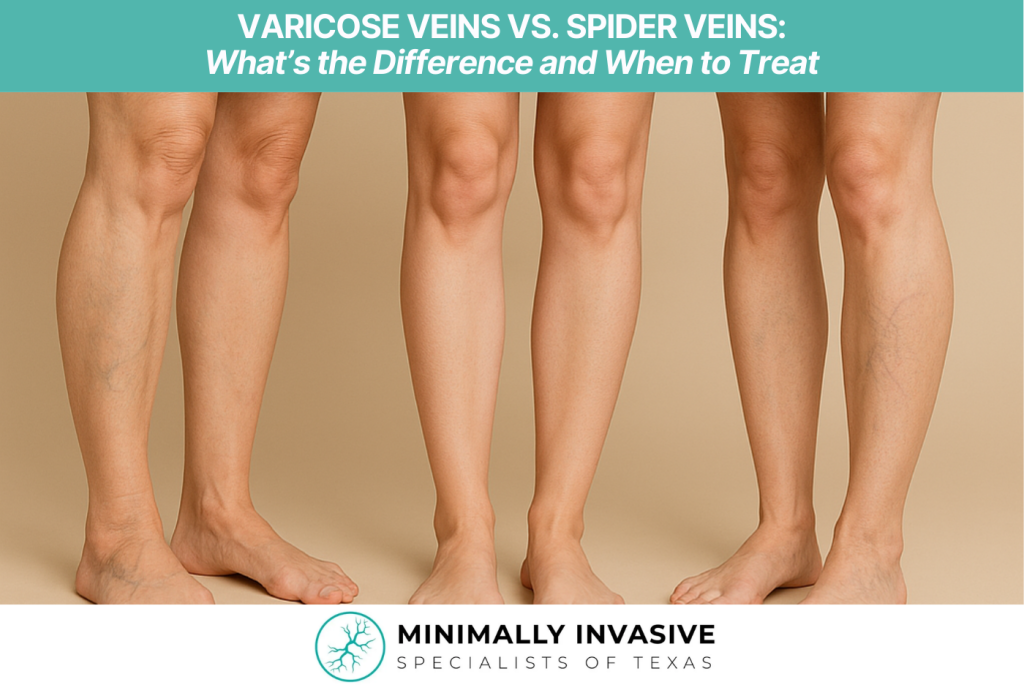
Vein problems are common, yet many people aren’t sure whether they’re dealing with varicose veins or spider veins—or how to treat them. Both conditions involve malfunctioning veins, but they differ in appearance, symptoms, and treatment approaches. Understanding these differences can help you make informed decisions about your vein health.
Understanding the Basics
Varicose Veins
Varicose veins are enlarged, twisted veins that often appear dark blue or purple. They occur when the valves inside the veins weaken, allowing blood to pool. Commonly found on the legs, varicose veins may bulge above the skin’s surface and can cause discomfort such as aching, heaviness, or swelling.
Spider Veins
Spider veins are smaller, web-like clusters of red, blue, or purple veins visible just under the skin. They usually appear on the legs or face. While they’re typically painless and mainly a cosmetic concern, they can sometimes indicate underlying venous issues.
Key Differences at a Glance
| Feature | Varicose Veins | Spider Veins |
| Size & Appearance | Large, bulging, rope-like | Thin, flat, web-like |
| Symptoms | Aching, swelling, heaviness, throbbing | Usually asymptomatic or mild itching |
| Risk Factors | Age, genetics, pregnancy, prolonged standing | Genetics, sun exposure, hormonal shifts |
| Treatment | Minimally invasive procedures often needed | Sclerotherapy or laser treatment |
Why Treatment Matters
Even if your veins aren’t painful, untreated varicose veins can lead to complications such as skin changes, ulcers, or blood clots. Spider veins may not pose medical risks, but they can signal early venous insufficiency. Seeking evaluation from a vascular specialist ensures you address both cosmetic concerns and potential health issues.
Modern, Minimally Invasive Treatment Options
At Minimally Invasive Specialists of Texas, we offer advanced procedures that require little downtime:
- Endovenous Laser Therapy (EVLT) – Uses targeted laser energy to close abnormal veins.
- Ultrasound-Guided Sclerotherapy – Injects a specialized solution to collapse unwanted veins.
- Radiofrequency Ablation (RFA) – Uses controlled heat to seal off faulty veins.
- Cosmetic Sclerotherapy – Treats spider veins for smoother, clearer skin.
These treatments are performed in our Pasadena office, allowing most patients to return to normal activities the same day.
Comprehensive Q&A
Q: Are varicose veins dangerous?
A: While not always dangerous, untreated varicose veins can cause complications like chronic swelling, skin changes, and even deep vein thrombosis (DVT).
Q: Can spider veins turn into varicose veins?
A: No. Spider veins don’t develop into varicose veins, but both can result from similar risk factors such as genetics or prolonged standing.
Q: What lifestyle changes help prevent vein problems?
A: Regular exercise, maintaining a healthy weight, wearing compression stockings, and elevating your legs can improve circulation and reduce risks.
Q: How do I know which treatment is right for me?
A: A diagnostic ultrasound and in-office consultation will determine whether you need medical treatment for varicose veins or cosmetic treatment for spider veins.
Q: Is treatment covered by insurance?
A: Medically necessary varicose vein treatments are often covered. Spider vein treatments are usually considered cosmetic and may not be covered.
Take the First Step Toward Healthier Legs
If you’re experiencing symptoms—or simply want to improve the appearance of your legs—our team can help you choose the safest, most effective treatment.
Minimally Invasive Specialists of Texas
4003 Woodlawn Ave
Pasadena, TX 77504
Phone: (832) 583-2246
Call today to schedule your consultation and learn how minimally invasive vein treatments can restore comfort and confidence.
